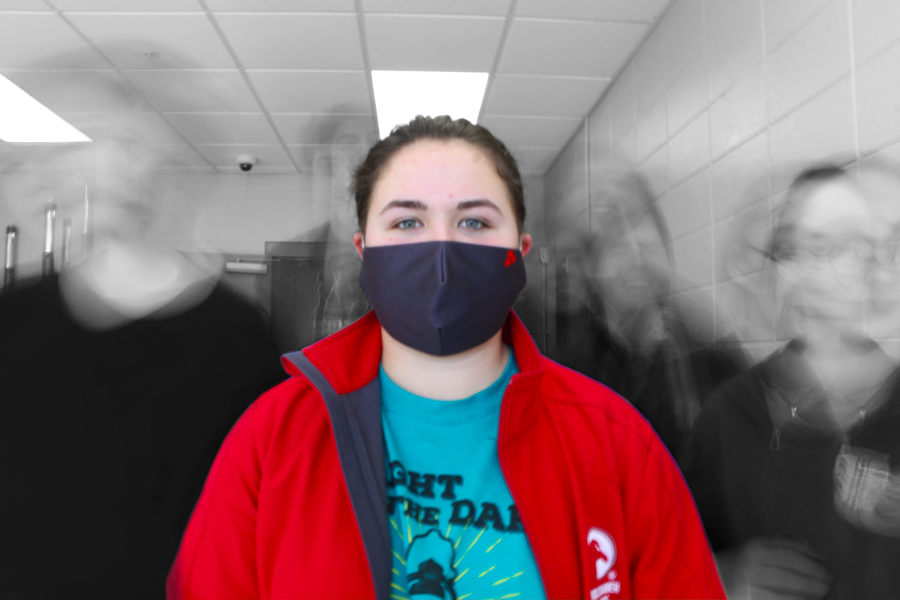The Pandemic is Still Not Over
Some students at Nixa High School still choose to wear masks, even though they are no longer required. “The best thing we can all do to reduce the risk of a nasty new variant is to get vaccinated and boosted and wear masks to give the virus as few chances to replicate as possible,” Dr. Lee-Ann Allen said.
March 2, 2022
As coronavirus tensions somewhat ease over the Omicron variant, the virus overall remains a looming threat.
Sophomore Ethan Warnecke continues to wear a mask, despite the Nixa school district ending the mandate.
“It protects me as well as other people,” Warnecke said. “My dad has a restaurant job, and there’s been several times when he might have picked something up, so I do it more as a consideration for others.”
Misinformation on social media is still a leading problem regarding COVID-19.
“Social media is a big reason why all this misinformation is going around … and it’s just scary how much power social media can have over people’s beliefs,” Warnecke said.
Melinda Lansdown is a registered nurse for Nixa. The recent breaks from school have kept the recent case rate down.
“We have had a very sharp decline [in cases] in the last week or so because of our snow break,” Lansdown said.
A way to combat the new variants is to practice social distancing.
“Social distancing during an illness, [or if] you’re around someone that you observe [is] having symptoms … keeping your distance from them [will help],” Lansdown said. “The regular things of washing your hands, covering your mouth when you cough are very important things.”
Americans are still struggling with the controversy over the way the U.S. has fought against the spread of COVID-19. Sophomore Caylee Cruise said she believes that wearing a mask should be up to the wearer.
“If you feel like you should wear it, that’s cool, but if you don’t, that’s cool as well,” Cruise said. “But I also feel like if you get sick, you might be smart to wear one just so people aren’t freaking out on you.”
Warnecke said people have the power to change the course of the pandemic.
“Freedom is important, but at the same time, … people just have to accept sometimes that bad things are happening and it’s hard to do that,” Warnecke said. “Sometimes people are the opposite; they look at all the bad stuff and think there’s no way to fix it.”
Dr. Lee-Ann Allen, chair of the Department of Molecular Microbiology and Immunology at the Missouri University School of Medicine, says that the cause for the new strains of COVID-19 are due to replication errors.
“As the virus replicates, mistakes are made when it copies its RNA genome,” Allen said. “Some of these mistakes can lead to changes in the sequence of the Spike protein or other components of the virus.”
Allen says that these changes can affect the virus as negatively as it can positively.
“In some cases, these changes have no effect or make the virus less fit,” Allen says. “Other changes enhance transmission of the virus from one person to another or increase disease severity. Viral variants that transmit better or are more virulent — which means they cause more severe disease — will out-compete other variants and become dominant in the human population.”
This is how waves of a certain variant can be observed at a given time, according to Allen.
“Beta replaced the original strain and was [then] out-competed by Delta last summer,” Allen said. “Omicron became dominant this fall [and] winter as it spreads much more readily between people.”
Allen warns that despite the tamer symptoms of Omicron, it does not mean future strains will not be worse.
“Just because COVID-19 disease caused by Omicron is less severe than Delta is no guarantee that subsequent variants will remain less severe.”
The Omicron variant has less severe symptoms, according to Allen, due to the location the strain prefers to infect.
“Omicron spreads more easily because it grows faster in cells of the upper airway and is less likely to infect the lungs — the lower airway,” Allen said. “Less virus in the lungs reduces the risk of pneumonia and the need to be on a ventilator.”
However, that decrease in severity does not correlate with infectivity.
“More abundant virus in the upper airway means that you will release more virus particles into the air with each breath, sneeze or cough and while talking or singing, which makes it likely to infect others who are nearby,” Allen said. “One thing to keep in mind is that in medical terms, ‘mild disease’ only means that you don’t need to be in the hospital. It does not mean that you don’t feel sicker than you ever have in your life or worse than when you had the flu. It also does not mean that you won’t have long-term consequences. COVID-19 infection can cause heart, lung and kidney damage even in patients who never had any symptoms.”
The concern of the effectiveness of the COVID-19 vaccine shares similarities to that of another vaccine 12 years ago.
“If we think back years ago [to] the Swine flu that we had around 2010, was a coronavirus,” Lansdown said. “That has been integrated as a yearly vaccine with our influenza vaccine … so I think it will integrate with our yearly flu rounds.”
Allen said that despite a dip in infections from the Omicron, it is still ambiguous as to what will come.
“At present, the Omicron wave is waning, but we don’t know what lies ahead,” Allen said. “We are all hoping for a milder variant, but there is no






